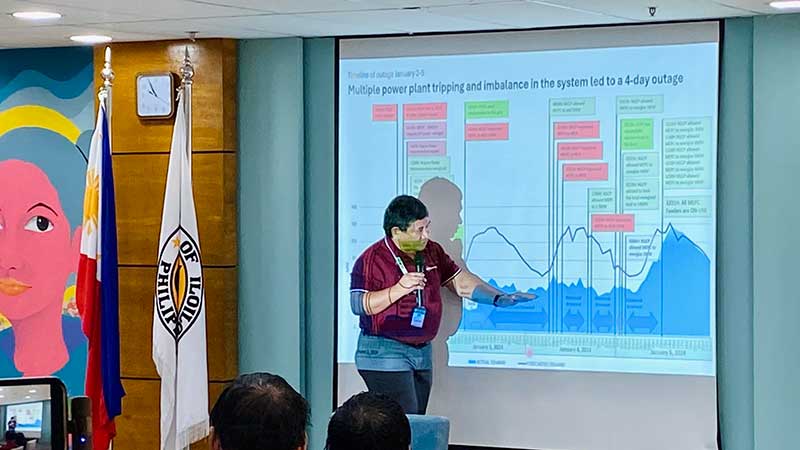By Joseph Bernard A. Marzan and Mariela Angella Oladive
A meeting of energy stakeholders in Iloilo City on Thursday, March 7, revealed bigger chinks in Panay’s energy supply grid.
The Iloilo City government led the multi-sectoral meeting with local and national government officials, national and local energy sector players, business sector members, and other key stakeholders.
One of the main points that was repeated throughout the meeting was the observation that the entire Panay Island only had one “door” to the Visayas grid, particularly the Panay-Negros Grid Interconnection between E.B. Magalona, Negros Occidental, and Barotac Viejo, Iloilo.
MORE Power President and CEO Roel Castro explained the situation of every sub-grid within the Cebu-Negros-Panay (CNP) Grid.
Negros Island has three grid Interconnectors including one via submarine cable, and the other two in the Negros-Cebu Grid Interconnections located in Calatrava, Negros Occidental and Amlan, Negros Oriental.
Cebu Island has 5 interconnectors, which include the two connected to Negros Island, as well as one each connecting to Leyte Island, Bohol Island, and the Mindanao-Visayas Grid Interconnection between Santander, Cebu, and Dapitan City, Zamboanga del Norte.
Castro said this constraint on the part of Panay and other factors has led to several challenges, including insufficient supply, inadequate protection coordination, and intermittent power imports, among others.
Global Business Power (GBP) First Vice President and Panay Site Head Antonio Jun Cabalhug Jr. also pointed this out, saying that the National Grid Corporation of the Philippines (NGCP), the country’s private grid operator, should “trim down” or “be elastic” on its power load.
“No matter how good the generation side, if [the] weakest link is the transmission side, all the problems may not be bullet-proofed. Using Mr. Castro’s example, the Panay Sub-grid is unique because we only have one door,” said Cabalhug.
“Imagine having only one door, and that being half-open, [and] because it is half-open, the [power] generation could not enter,” he added.
Because of the power instability in the island, Cabalhug said their primary location in Ingore, LaPaz, Iloilo City is not robust enough to absorb all of these problems.
He pointed to the March 2024 outage, which was caused by two power plants operated by GBP subsidiary, Panay Energy Development Corp (PEDC).
“We were talking about why the PEDC’s Unit 3 generated maximum power. It was because it was responding, because it was in the loop center, and the voltage is very low here when it comes from Cebu,” he stated.
As expected, Iloilo City Mayor Jerry Treñas blew his top at the NGCP with delays in its interconnection projects, especially the CNP Stage 3 and the Luzon-Mindoro-Panay Grid.
The delays in the completion of the CNP Stage 3 have been the subject of legal controversy, including a motion for intervention by the city government itself.
The Luzon-Mindoro-Panay Grid, meanwhile, is one of the planned projects of the NGCP which will serve as another “door” to other grids in Mindoro and mainland Luzon, but is set to be operational only by 2040.
“The [CNP Stage 3] has been delayed for so long. Why are you delaying this, while you continue to do the other transmission lines? How many years has this been delayed? You keep pointing and blaming other people for your shortcomings,” Treñas told NGCP.
He also said that other metropolitan areas such as Manila, Cebu, and Davao never suffered massive blackouts.
“Can you imagine this happening in Cebu [or in] Davao [or] the [National Capital Region]? Why will this [power outage] happen here? Are we less of a Filipino compared to those people? Why do these things keep on happening in Iloilo? […] There is really something inherently wrong in what you are doing here,” the mayor said.
NGCP’s Assistant Vice President for Visayas Systems Operations Christian Ereño responded that they remained committed to their existing timelines, including energizing lines in Negros Occidental in March 2024, as part of the CNP Stage 3 development.
As to the uniqueness of the situation in Panay, Ereño said that there have not been any multiple trippings in the power plants that supply to Cebu and Davao.
ANCILLARY SERVICES
Another concern was NGCP’s ancillary services or backup power sources, including two in Panay – the Panay Power Corporation (PPC) in Nabas, Aklan, and of SPC Island Power Corporation in Dingle, Iloilo. While both are active, they are not readily connected to the grid.
The current contingency reserves that supply the Panay subgrid in case of loss, which are actively connected to the grid, are power plants located in Toledo City, Cebu, and in Isabel, Leyte.
MORE Power has recently expressed its intention to recommission Panay Power Corporation’s diesel plant in Ingore, which may provide between 50 to 60 megawatts. Of power
Provincial Legal Officer Dennis Ventilacion suggested to the Department of Energy (DOE) that it should specifically include zonal allocation of Panay in the next bidding for the ancillary services, to lessen the dependency on plants outside of the island.
DOE-Electric Power Industry Management Bureau Director Irma Exconde said that MORE Power and GBP must still seek recommendations from NGCP that the plant is viable before it may be able to bid to provide the said ancillary services.






















